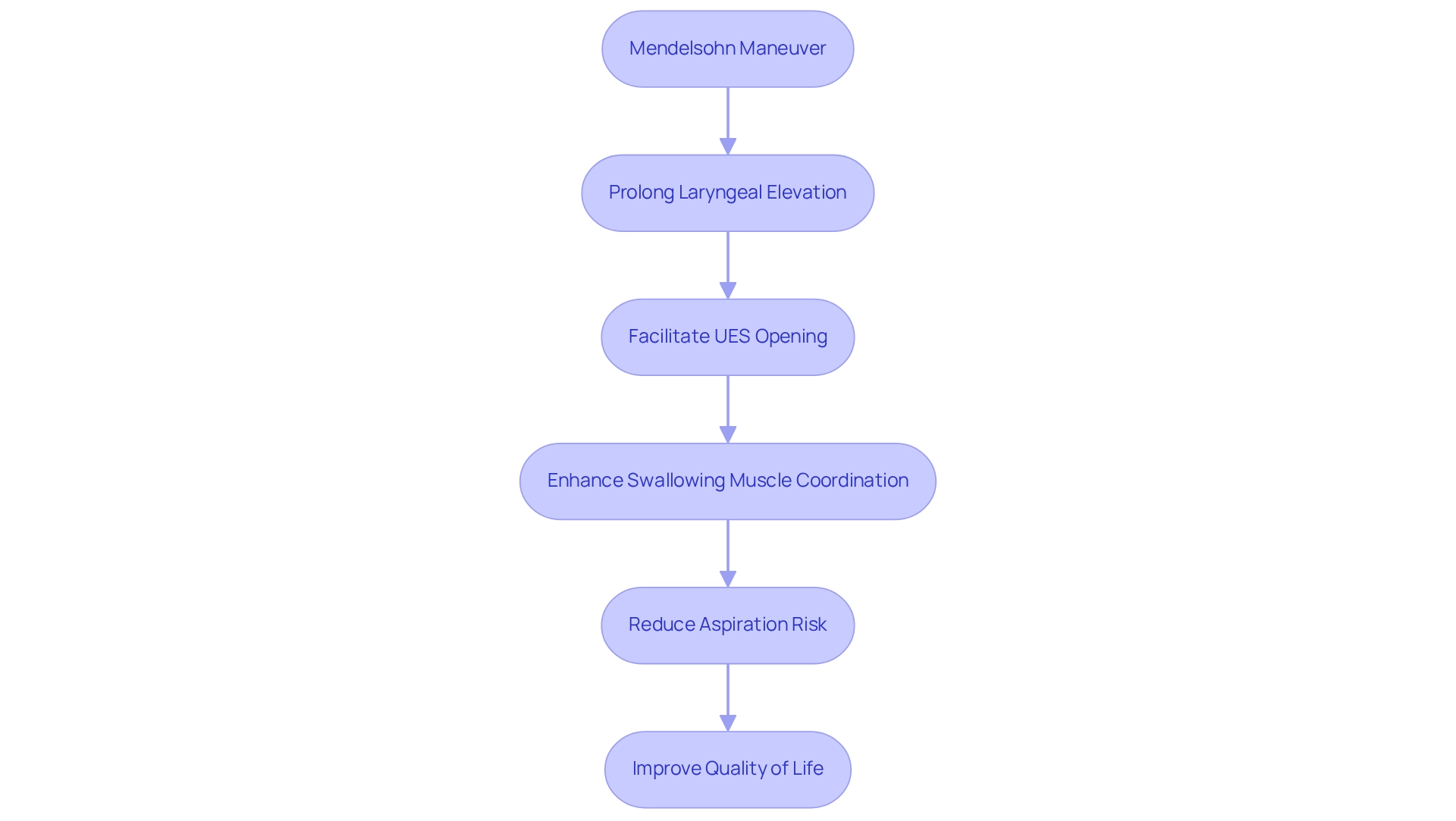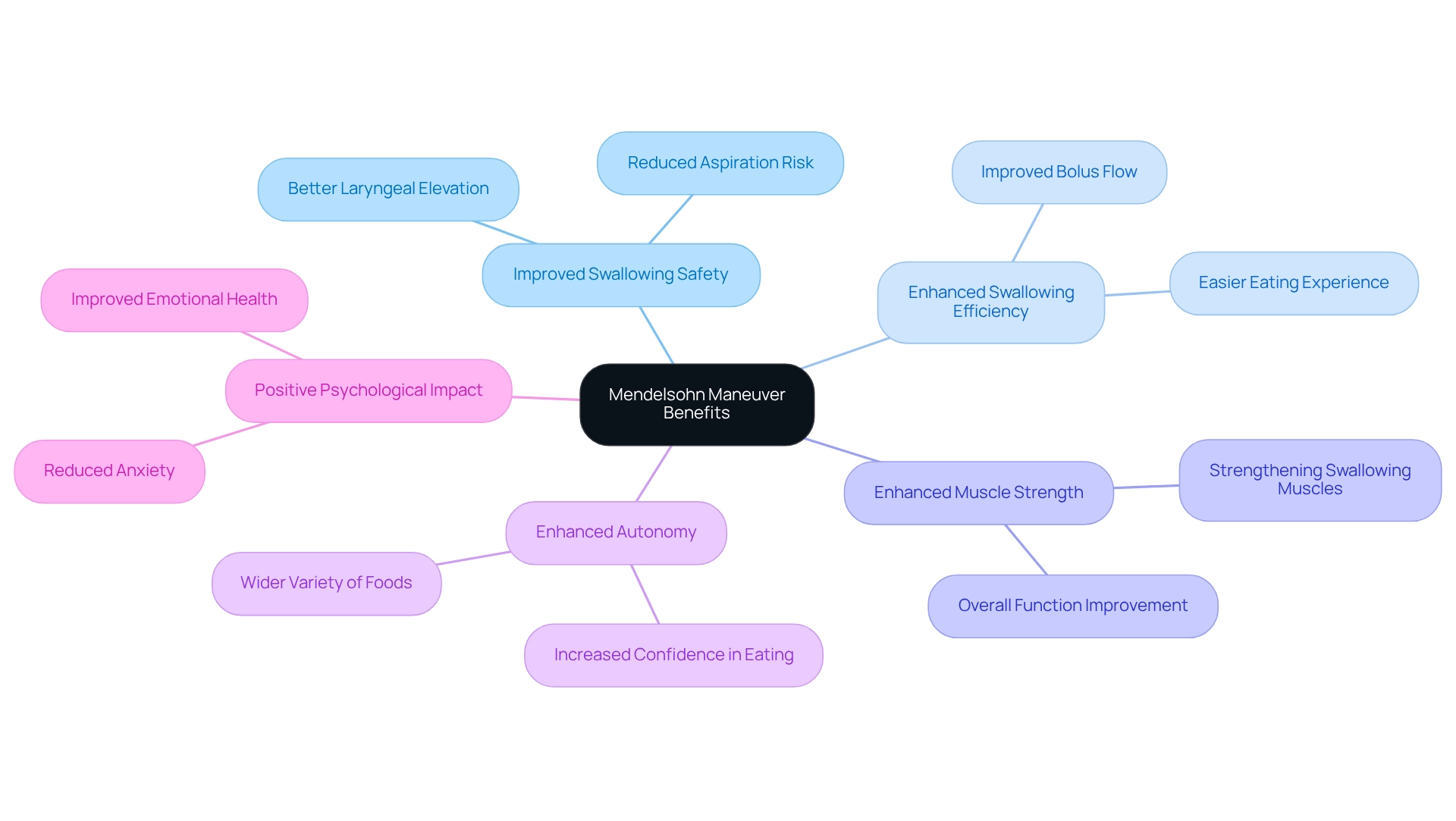Overview
The Mendelsohn Maneuver is a compassionate therapeutic technique designed to enhance swallowing safety and efficiency for individuals experiencing dysphagia. By prolonging laryngeal elevation during ingestion, this approach not only reduces the risk of aspiration but also strengthens the muscles involved in swallowing. Imagine feeling more confident during meals, knowing that your safety is prioritized.
Research supports the significant improvements in swallowing function and overall patient well-being that this technique can bring. As a result, many individuals report a better quality of life and more enjoyable eating experiences. We’re here for you, ensuring that each meal can be a moment of joy rather than concern.
If you or a loved one are facing challenges with swallowing, consider exploring the benefits of the Mendelsohn Maneuver. Your comfort is our priority, and we are dedicated to providing the care and support you need to navigate these challenges. Together, we can work towards a healthier, happier mealtime experience.
Introduction
In the realm of dysphagia treatment, the Mendelsohn Maneuver stands as a beacon of hope for those struggling with swallowing difficulties. This specialized technique not only enhances the safety and efficiency of swallowing but also plays a crucial role in preventing aspiration, a common risk among seniors. By deliberately prolonging laryngeal elevation during swallowing, patients can significantly improve their muscle coordination, leading to better outcomes and a reduced likelihood of complications.
As the prevalence of dysphagia continues to rise, it’s important to understand and implement effective strategies like the Mendelsohn Maneuver. These strategies are essential for enhancing patients’ quality of life and overall health. This article delves into the intricacies of the maneuver, outlining its step-by-step execution, clinical benefits, and the profound impact it can have on patient well-being. Remember, we’re here for you, and your comfort is our priority.
Define the Mendelsohn Maneuver and Its Role in Dysphagia Treatment
The Mendelsohn Maneuver is a specialized therapeutic technique designed to improve safety and efficiency during ingestion for individuals with dysphagia, a condition that affects many seniors. This maneuver involves intentionally prolonging laryngeal elevation while eating, which facilitates the opening of the upper esophageal sphincter (UES) and helps prevent aspiration. By elevating the larynx and maintaining it at its peak position, patients can enhance the coordination of their swallowing muscles, significantly reducing the risk of food or liquid entering the airway.
Research indicates that the Mendelsohn maneuver is particularly beneficial for patients with reduced laryngeal excursion or limited cricopharyngeal opening. A study aimed at providing a basis for applying this technique in rehabilitation clinics highlighted that implementing the maneuver resulted in increased pharyngeal peak contraction and duration, crucial for effective bolus propulsion into the esophagus. K. Bodén from the Department of Radiology at Karolinska University Hospital observed, “With the maneuver, we discovered that both the pharyngeal peak contraction and contraction duration were enhanced, which could lead to better propulsion of bolus into the esophagus.”
Furthermore, a comparative examination of different intervention techniques showed that participants employing the Mendelsohn maneuver exhibited significant enhancements in their quality of life scores related to eating (SWAL-QOL). This was particularly evident in aspects concerning symptoms, communication, and sleep. Specifically, the group using the Mendelsohn maneuver demonstrated notable improvements compared to both the NMES and compound intervention groups, underscoring its effectiveness.
The significance of laryngeal elevation in swallowing rehabilitation cannot be overstated, as it plays a crucial role in ensuring safe ingestion. Expert opinions highlight the effectiveness of the Mendelsohn maneuver, indicating that it should be a key element in the management plans for swallowing disorders. As the prevalence of dysphagia among seniors continues to rise in 2025, understanding and applying techniques such as the Mendelsohn maneuver becomes increasingly crucial for enhancing patient outcomes and quality of life. Additionally, the need for larger participant numbers and variations in treatment regimens for future investigations is essential to further validate these findings and improve treatment protocols.

Explain the Technique: Step-by-Step Guide to Performing the Mendelsohn Maneuver
To effectively perform the Mendelsohn Maneuver, let’s take a moment to walk through these detailed steps together:
- Preparation: Begin by sitting or standing comfortably in an upright position. It’s important to ensure that you feel relaxed and focused on the task at hand.
- Identify the Larynx: Gently place your fingers on your neck to locate your larynx (voice box), commonly referred to as the Adam’s apple. This connection is vital in understanding your body.
- Begin Ingestion: Take a small sip of water or a bite of food and hold it in your mouth without ingesting right away. This pause allows you to prepare for the next step.
- Elevate the Larynx: As you start to swallow, feel your larynx rise. At the peak of this elevation, tighten your throat muscles to hold the position. This action is crucial for effective swallowing.
- Hold the Position: Maintain the larynx in this elevated position for 2-3 seconds while continuing to swallow. This practice helps strengthen your muscles.
- Release: After holding, allow your larynx to return to its resting position as you complete the swallow. It’s important to listen to your body during this process.
- Practice: Repeat this maneuver several times during each meal or eating exercise session. Consistent practice can enhance muscle strength and coordination.
By incorporating the Mendelsohn Maneuver into your daily routine, you may notice significant improvements in your swallowing function over time. Research suggests that methods like this have demonstrated high reliability in evaluations, reinforcing their effectiveness in swallowing rehabilitation. For example, a study named “Reliability of Eating Measures in Dysphagia Research” found high reliability for primary metrics of duration, indicating that the methods employed in the research were robust and could be relied upon for future studies in dysphagia rehabilitation. Furthermore, enhancements were noted in various ingestion measures, as mentioned by Gary H. McCullough, who stated, “Enhancements were noted also in HMAE, HME, and MWUESO, and enhancements were more substantial after periods of treatment than without treatment.”
In addition, the mental health score for the Compound Intervention Program was reported at 18.5 ± 2.3, emphasizing the potential advantages of ingestion interventions on overall well-being. Remember, we’re here for you, and your comfort is our priority as you strive for improved eating results.

Discuss the Benefits: Clinical Outcomes and Patient Quality of Life Improvements
The Mendelsohn Maneuver offers several clinical benefits that can greatly improve the quality of life for individuals facing dysphagia.
- Improved Swallowing Safety: This technique encourages better laryngeal elevation and upper esophageal sphincter (UES) opening, which effectively reduces the risk of aspiration. This is crucial, as aspiration can lead to pneumonia and other serious complications.
- Enhanced Swallowing Efficiency: Many patients share that they experience improved bolus flow through the pharynx, making eating easier and more effective.
- Enhanced Muscle Strength: Regular practice of the maneuver strengthens the muscles involved in swallowing, contributing to better overall function.
- Enhanced Autonomy: As patients gain confidence in their eating abilities, they often find joy in enjoying a wider variety of foods and liquids, enriching their meal experiences and social interactions.
- Positive Psychological Impact: Successfully managing swallowing difficulties can ease anxiety and improve emotional health, leading to an overall enhancement in quality of life.
Research shows that patients who incorporate the Mendelsohn Maneuver into their rehabilitation programs see significant improvements in swallowing function and overall health. A multidisciplinary approach is essential for effective care. Studies reveal that complex intervention strategies are vital in enhancing quality of life and reducing aspiration risks, particularly for older adults facing swallowing challenges. Margarita Rugaitienė underscores this point, stating, “Thus, summarizing the results of the study, it can be said that complex management of oropharyngeal swallowing difficulties plays an important role in enhancing the quality of life and reducing aspiration risk in older individuals affected by this condition.”
Furthermore, the development of user-friendly assessment tools, such as the miniDADI, reflects ongoing efforts to improve dysphagia management and patient outcomes. It’s important to note that the MDADI was found to be the most challenging tool to read, requiring a ‘college level’ of literacy. This highlights the necessity for accessible assessment methods to ensure effective treatment.
We’re here for you, and your comfort is our priority. If you or a loved one is experiencing swallowing difficulties, consider reaching out for support and guidance.

Conclusion
The Mendelsohn Maneuver stands out as a vital technique in treating dysphagia, especially for seniors who struggle with swallowing. By promoting laryngeal elevation and helping to open the upper esophageal sphincter, this maneuver greatly enhances both the safety and efficiency of swallowing. Research backs its effectiveness, revealing significant improvements in muscle coordination and a lower risk of aspiration, which is crucial for preventing serious complications.
Incorporating the steps of the Mendelsohn Maneuver into daily routines not only strengthens essential muscles but also nurtures greater independence in patients. This newfound confidence empowers individuals to savor a wider variety of foods and beverages, enriching their social interactions and meal experiences. Additionally, the psychological benefits of managing dysphagia are noteworthy; patients often share feelings of reduced anxiety and improved emotional well-being.
As we recognize the growing prevalence of dysphagia, it becomes increasingly important to understand and utilize effective strategies like the Mendelsohn Maneuver. With its proven clinical benefits and positive impact on quality of life, this technique should be a cornerstone of dysphagia treatment plans. Embracing such interventions is essential for enhancing patient outcomes and ensuring a safer, more fulfilling life for those affected by swallowing disorders. Remember, we’re here for you, and your comfort is our priority.
Frequently Asked Questions
What is the Mendelsohn Maneuver?
The Mendelsohn Maneuver is a specialized therapeutic technique designed to improve safety and efficiency during ingestion for individuals with dysphagia, a condition affecting many seniors. It involves intentionally prolonging laryngeal elevation while eating to facilitate the opening of the upper esophageal sphincter (UES) and help prevent aspiration.
How does the Mendelsohn Maneuver benefit individuals with dysphagia?
By elevating the larynx and maintaining it at its peak position, the maneuver enhances the coordination of swallowing muscles, significantly reducing the risk of food or liquid entering the airway. It is particularly beneficial for patients with reduced laryngeal excursion or limited cricopharyngeal opening.
What research supports the effectiveness of the Mendelsohn Maneuver?
Research indicates that implementing the Mendelsohn Maneuver results in increased pharyngeal peak contraction and duration, which are crucial for effective bolus propulsion into the esophagus. A study highlighted improvements in quality of life scores related to eating, communication, and sleep among participants using the maneuver compared to other intervention groups.
What improvements did participants experience when using the Mendelsohn Maneuver?
Participants employing the Mendelsohn Maneuver exhibited significant enhancements in their quality of life scores related to eating, particularly regarding symptoms, communication, and sleep.
Why is laryngeal elevation important in swallowing rehabilitation?
Laryngeal elevation plays a crucial role in ensuring safe ingestion. It is an essential element in the management plans for swallowing disorders, especially as the prevalence of dysphagia among seniors continues to rise.
What is the need for future research on the Mendelsohn Maneuver?
There is a need for larger participant numbers and variations in treatment regimens in future investigations to further validate the findings related to the Mendelsohn Maneuver and improve treatment protocols for dysphagia.











